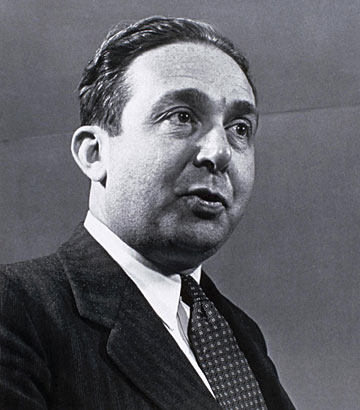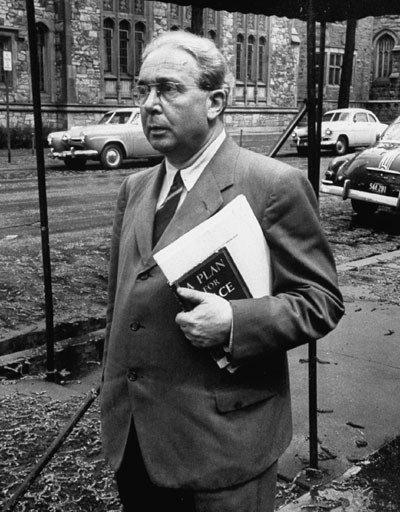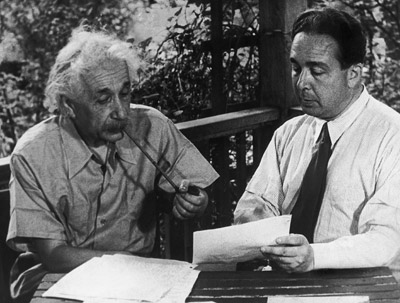<Back to Index>
- Physicist Leó Szilárd, 1898
- Architect and Designer Arne Emil Jacobsen, 1902
- King of Egypt and the Sudan Farouk I, 1920
PAGE SPONSOR


Leó Szilárd (Hungarian: Szilárd Leó, February 11, 1898 – May 30, 1964) was a Hungarian physicist who conceived the nuclear chain reaction in 1933, patented the idea of a nuclear reactor with Enrico Fermi, and in late 1939 wrote the letter for Albert Einstein's signature that resulted in the Manhattan Project, and the atomic bomb. He was born in Budapest in the Austro-Hungarian Empire, and died in La Jolla, California.
Szilárd was born into a Jewish family of Budapest at the time of the Austro-Hungarian monarchy before World War I as the son of a civil engineer. From 1908 – 1916 he attended Reáliskola in his home town. He was enrolled as an engineering student at Budapest Technical University during 1916 but had to join the Austro-Hungarian Army during
1917 as officer candidate where he was discharged honorably at the end
of the war. During 1919 he resumed engineering studies at Budapest
Technical University but soon decided to leave Hungary because of the
rising antisemitism under the Horthy regime which caused the introduction of a numerus clausus for Jewish students at Hungary's universities. He continued engineering studies at Technische Hochschule (Institute of Technology) in Berlin-Charlottenburg. He soon changed to physics there and took physics classes from Einstein, Planck, and Max von Laue. His dissertation on thermodynamics Über die thermodynamischen Schwankungserscheinungen (On The Manifestation of Thermodynamic Fluctuations) during 1922 was praised by Einstein and awarded the highest honor. During 1923 he received the doctorate in physics from the Humboldt University of Berlin.
He was appointed as assistant to von Laue at the University of Berlin's
Institute for Theoretical Physics during 1924. During 1927 he finished
his habilitation and became a Privatdozent (instructor)
in Physics at University of Berlin. During his time in Berlin he was
working on numerous technical inventions (1928 German patent application on the linear accelerator, 1929 German patent application on the cyclotron, since 1926 work with Einstein on the construction of a refrigerator without moving parts (US patent 1,781,541 on
November 11, 1930)). Szilard's 1929 paper, "Uber die
Entropieverminderung in einem thermodynamischen System bei Eingriffen
intelligenter Wesen" (On the lessening of entropy in a thermodynamic
system by interference of an intelligent being) Z. Physik 53, 840-856,
introduced the thought experiment now called Szilard's engine and was important in the history of attempts to understand Maxwell's demon. During 1933 Szilárd fled to London to escape Nazi persecution, where he read an article in The Times summarizing a speech given by Ernest Rutherford which rejected the possibility of using atomic energy for practical purposes: We
might in these processes obtain very much more energy than the proton
supplied, but on the average we could not expect to obtain energy in
this way. It was a very poor and inefficient way of producing energy,
and anyone who looked for a source of power in the transformation of
the atoms was talking moonshine. But the subject was scientifically
interesting because it gave insight into the atoms. Although nuclear fission had
not yet been discovered, Szilárd was reportedly so annoyed at
this dismissal that he conceived of the idea of the nuclear chain
reaction while walking to work at St Bartholomew's Hospital waiting for traffic lights to change on Southampton Row in Bloomsbury. The following year he filed for a patent on the concept. Szilárd first attempted to create a chain reaction using beryllium and indium, but these elements did not produce a chain reaction. During 1936, he assigned the chain reaction patent to the British Admiralty to ensure its secrecy (GB patent 630726). Szilárd also was the co-holder, with Nobel Laureate Enrico Fermi, of the patent on the nuclear reactor (U.S. Patent 2,708,656). During 1938 Szilárd accepted an offer to conduct research at Columbia University in Manhattan, and moved to New York, and was soon joined by Fermi. After learning about the successful nuclear fission experiment conducted during 1939 in Germany by Otto Hahn, Fritz Strassmann, Lise Meitner, and Otto Robert Frisch, Szilárd and Fermi concluded that uranium would
be the element capable of sustaining a chain reaction. Szilárd
and Fermi conducted a simple experiment at Columbia and discovered
significant neutron multiplication in uranium, proving that the chain
reaction was possible and enabling nuclear weapons. Szilárd
later described the event: "We turned the switch and saw the flashes.
We watched them for a little while and then we switched everything off
and went home." He understood the implications and consequences of this
discovery, though. "That night, there was very little doubt in my mind
that the world was headed for grief." At
around that time the Germans and others were in a race to produce a
nuclear chain reaction. German attempts to control the chain reaction
sought to do so using graphite, but these attempts proved unsuccessful.
Szilárd realized graphite was indeed perfect for controlling
chain reactions, just as the Germans had determined, but that the
method of producing graphite used boron carbide rods, and the minute amount of boron impurities
in the manufactured graphite was enough to stop the chain reaction.
Szilárd had graphite manufacturers produce boron-free graphite.
As a result, the first human-controlled chain reaction occurred on 2
December 1942. Szilárd was directly responsible for the creation of the Manhattan Project. He drafted a confidential letter to Franklin D. Roosevelt explaining the possibility of nuclear weapons, warning of Nazi work on such weapons and
encouraging the development of a program which could result in their
creation. During August 1939 he approached his old friend and
collaborator Albert Einstein and convinced him to sign the letter, lending his fame to the proposal. The Einstein–Szilárd letter resulted
in the establishment of research into nuclear fission by the U.S.
government and ultimately to the creation of the Manhattan Project; FDR
gave the letter to an aide, General Edwin M. "Pa" Watson with the instruction: "Pa, this requires action!" Later, Szilárd relocated to the University of Chicago to continue work on the project. There, along with Fermi, he helped to construct the first "neutronic reactor", a uranium and graphite "atomic pile" in which the first self-sustaining nuclear chain reaction was achieved, during 1942. As
the war continued, Szilárd became increasingly dismayed that
scientists were losing control over their research to the military, and
argued many times with General Leslie Groves, military director of the project. His resentment towards the U.S. government was exacerbated by his failed attempts to avoid the use of the atomic bomb in war through
having a test organized that could be witnessed by Japanese observers
who would then have the opportunity to surrender and spare lives. Szilárd became a naturalized citizen of the United States during 1943. During 1932, Szilárd had read about the fictional "atomic bombs" described in H.G. Wells's science fiction novel The World Set Free. This inspired him to be the first scientist to examine seriously the science of the creation of nuclear weapons. As a scientist, he was the first person to conceive of a device that, using a nuclear chain reaction as fuel, could be used as a bomb. As a survivor of a devastated Hungary after World War I, and having witnessed the subsequent terror of the Reds and the Whites, Szilárd developed an enduring passion for the preservation of human life and freedom, especially freedom to communicate ideas. He
hoped that the U.S. government would not use nuclear weapons because of
their potential for use against civilian populations. Szilárd
hoped that the mere threat of such weapons would force Germany and/or
Japan to surrender. He drafted the Szilárd petition advocating
demonstration of the atomic bomb. However with the European war
concluded and the U.S. suffering many casualties in the Pacific Ocean
region, the new U.S. President Harry Truman agreed with advisers and chose to use atomic bombs against Hiroshima and Nagasaki over the protestations of Szilárd and other scientists.
During
1947, Szilárd switched topics of study because of his horror of
atomic weapons, changing from physics to molecular biology, working extensively with Aaron Novick. He, Szilárd, proposed, during February 1950, a new kind of nuclear weapon using cobalt as a tamper, a cobalt bomb, which he said might destroy all life on the planet. U.S. News & World Report featured
an interview with Szilárd in its August 15, 1960 issue,
"President Truman Didn't Understand." He argued that "violence would
not have been necessary if we had been willing to negotiate." During
1961 Szilárd published a book of short stories, The Voice of the Dolphins, in which he dealt with the moral and ethical issues raised by the Cold War and his own role in the development of atomic weapons.
The title story described an international biology research laboratory
in Central Europe. This became reality after a meeting in 1962 with Victor F. Weisskopf, James Watson and John Kendrew. When the European Molecular Biology Laboratory was established, the library was named The Szilard Library and the library stamp features dolphins. Szilárd married Gertrud Weiss in 1951. During 1960, Szilárd was diagnosed with bladder cancer. He underwent radiation therapy at New York's Memorial Hospital using
a treatment regimen that he designed himself. A second round of
treatment followed during 1962; Szilárd's cancer remained in
remission thereafter. During 1962, Szilárd was part of a group
of scientists who founded the Council for a Livable World.
The Council's goal was to warn the public and Congress of the threat of
nuclear war and encourage rational arms control and nuclear
disarmament. He spent his last years as a fellow of the Salk Institute in San Diego. During May 1964, Szilárd died in his sleep of a heart attack at the age of sixty-six.
